Japan Trip – Part 2
This is part two in a two-part series on my trip to Japan. You can read Part 1 here.
Here’s a short recap about the trip:
My husband Ted and I took a two-week trip to Japan in late November/early December 2019. The main reason was to visit our son, a junior in college at DePaul University in Chicago, who is doing a semester abroad at Kansai Gaidai University in Osaka.
I waited 30 years for this adventure, and it was definitely worth the wait! I was living in NYC back then, working odd jobs and trying to find something I was passionate about. My father was in Japan for the summer, and my mother took me with her on a short vacation to see him and tour around a bit. I already had an interest in paper, but that trip was a turning point: we stayed in a traditional inn in Kyoto (a ryokan) and being surrounded by light filtering through shoji screens sparked a new interest in paper and light.
––––––––––––––––––––––––––––––––––––––––––––––––––––––––––––––––––––––––
Our Kyoto Airbnb was bare bones, and my husband says he’ll take over booking accommodations in the future. It was inexpensive though (I’d rather spend my money on paper!) and the neighborhood had lots of amenities and good food, plus we had bicycles! We were on the ground floor, and one of the issues was that we could hear the people upstairs snoring!
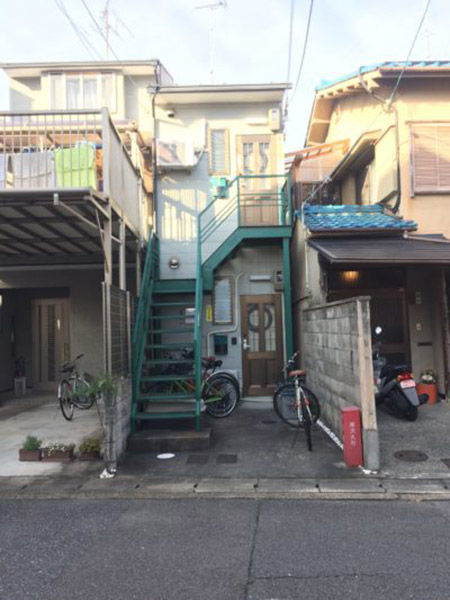
Sunday, 12/1: Hiroshima was sobering. We met Will at Kyoto Station and took the shinkansen to Hiroshima (I think we took one we shouldn’t have been on with our Japan Rail Pass, but thankfully, nobody checked our ticket)! We got to town around noon and walked through a big shopping mall, had lunch and then walked to the Peace Park and museum.
The Hiroshima Peace Memorial (Genbaku Dome) is the only structure left standing near the hypocenter of the first atomic bomb, which exploded on the 6 of August, 1945, and it remains in the condition it was in right after the explosion.
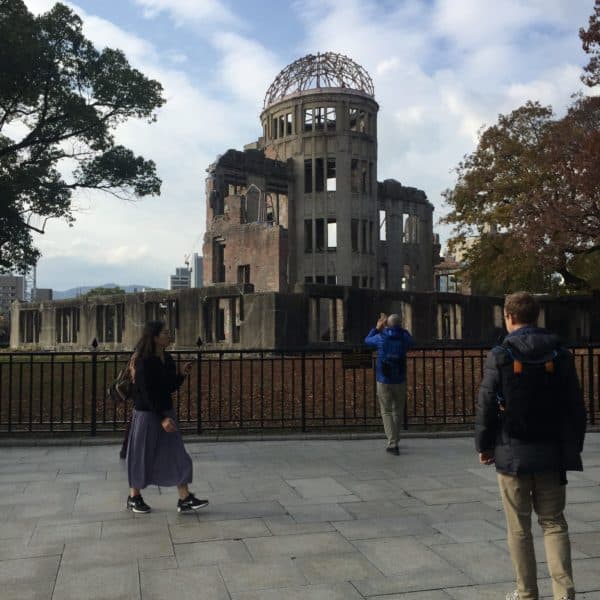
The Children’s Peace Monument stands in memory of all the children who died as a result of the atomic bombing. The monument was originally inspired by the death of Sadako Sasaki to radiation from the bombing at the age of two. Ten years later she developed leukemia, which eventually took her life. Her death compelled her classmates to begin a call for the construction of a monument dedicated to all children who died due to the atomic bomb.
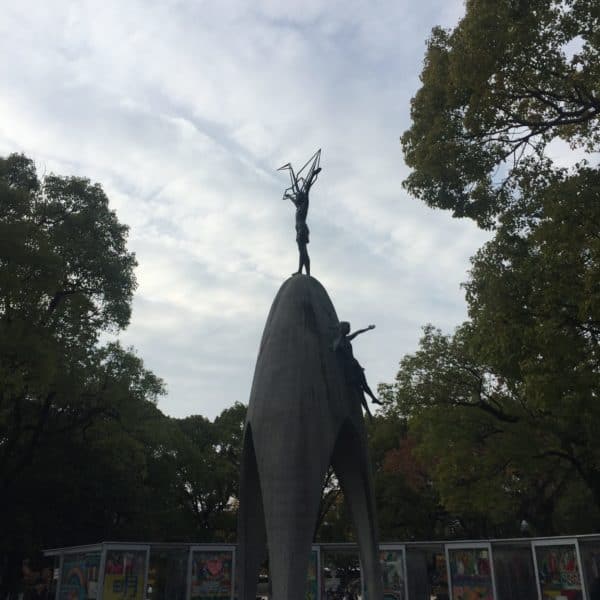
Soon after Sadako went into hospital, her Father told her the Japanese legend that if you fold one thousand paper cranes you would be granted a wish. Sadako began to fold cranes. Despite being very tired and in a lot of pain, she folded cranes from scrap paper, because paper was very rare and expensive back then, and she folded 1000 cranes and made her wish: to get well, and also for her parents to have more money, as they were quite poor. Sadako then started to try and fold another 1000 cranes. Sadly, she only managed to fold around 600 more cranes before she died. It was 25th October 1955. On the day of the funeral, each of her classmates put a paper crane that they had folded into her coffin. Today, groups send cranes which are displayed near the monument (in batches of 1000, I think).
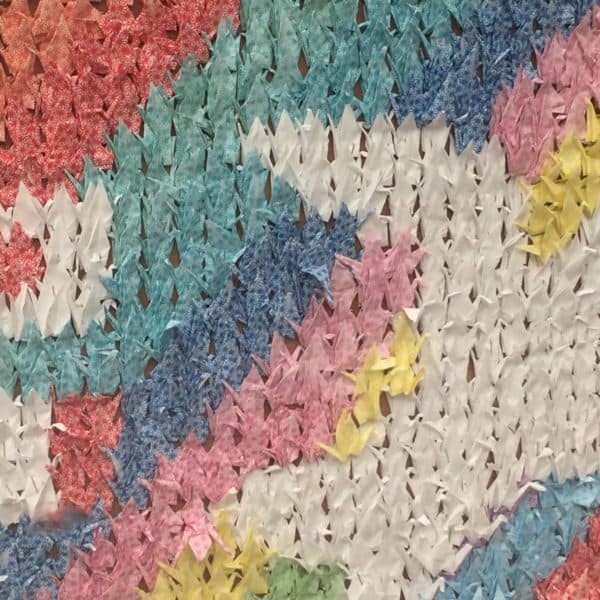
We received this postcard with our admission when we went to the Hiroshima Peace Memorial Museum. We walked through the exhibit elbow to elbow with others, and this was the most sobering experience of the day. The colored flecks in the card are from recycled cranes.
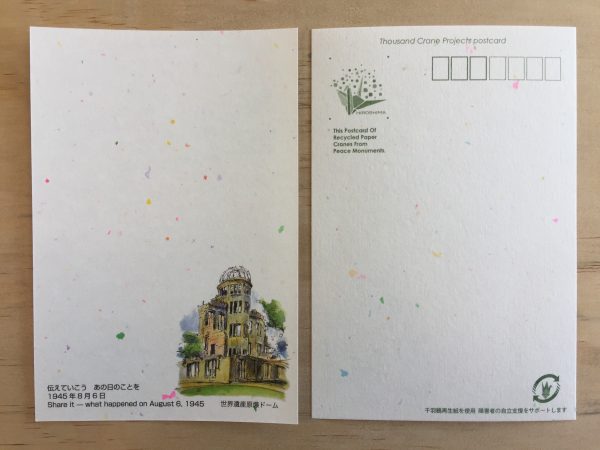
This beautiful gingko tree was in full bloom outside of the museum.
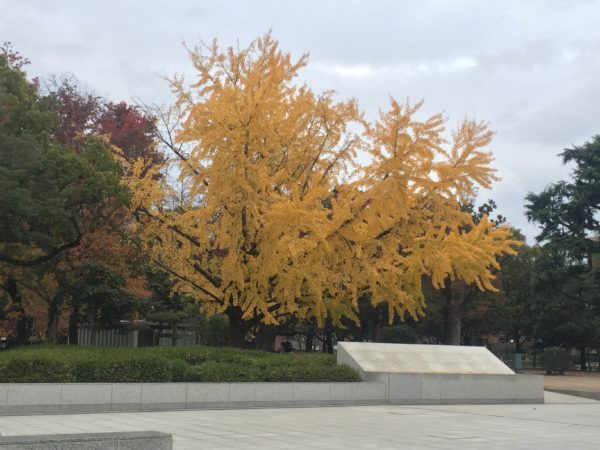
We took a slower train back and arrived in Kyoto around 9pm, had dinner in the station, and then parted ways with Will and headed back to our Airbnb.
––––––––––––––––––––––––––––––––––––––––––––––––––––––––––––––––––––––––
Monday, 12/2: When I was working at Dieu Donné Papermill in NYC in the mid-1990’s, I met Craig Ancelowitz, who was a buyer for Kate’s Paperie. Craig has lived in Asia for at least a decade, and he married into the Fujimori family which runs the Awagami Mill in Tokushima. You can learn more by listening to my interview with Craig on Paper Talk. We didn’t have time to get down there, but Craig lives in Osaka and met us at the Awagami Guesthouse which is in Kyoto. What a lovely place, filled with paper produced at Awagami. Here’s the entrance:
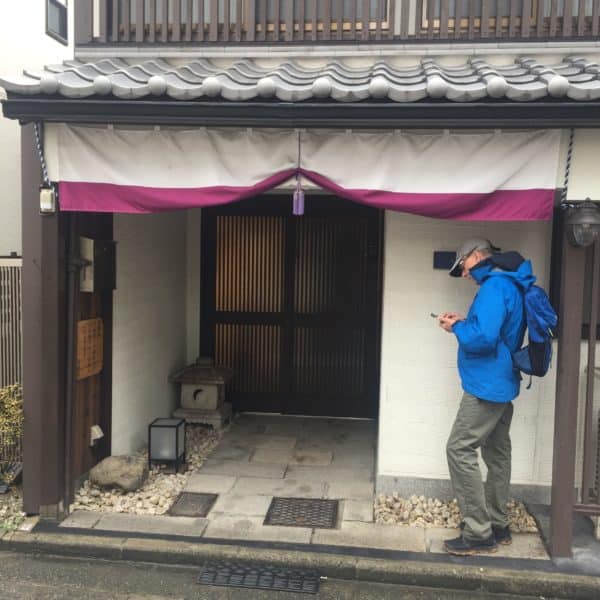
Wall paper & Lighting:
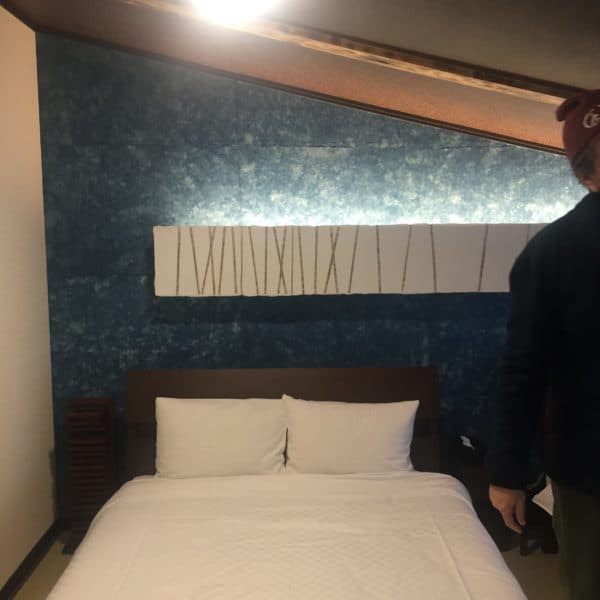
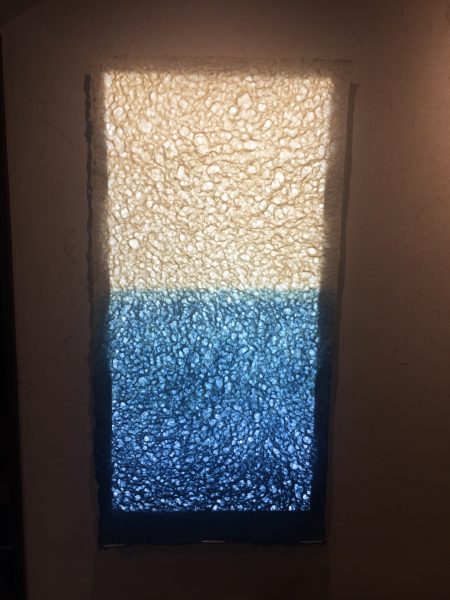
Shoji panels:

Fusuma (papered sliding doors). Mrs. Fujimori, Craig’s mother-in-law, specializes in indigo dyeing.
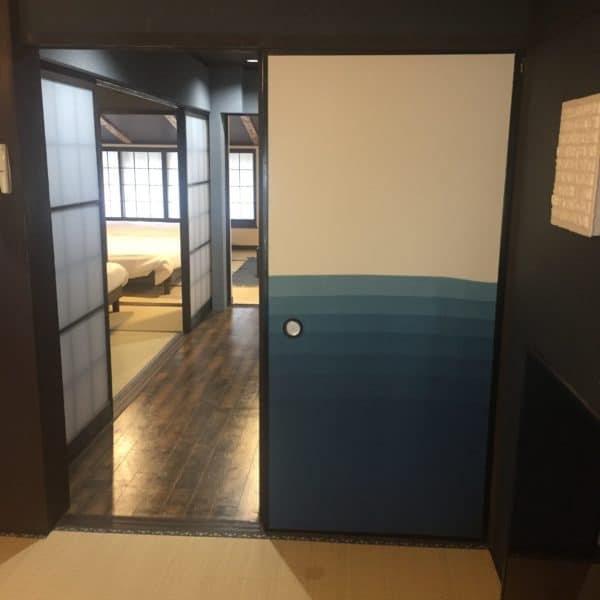
This is an Awagami paper that lends itself to ink jet printing. Yes, these panels are ink jet printed.
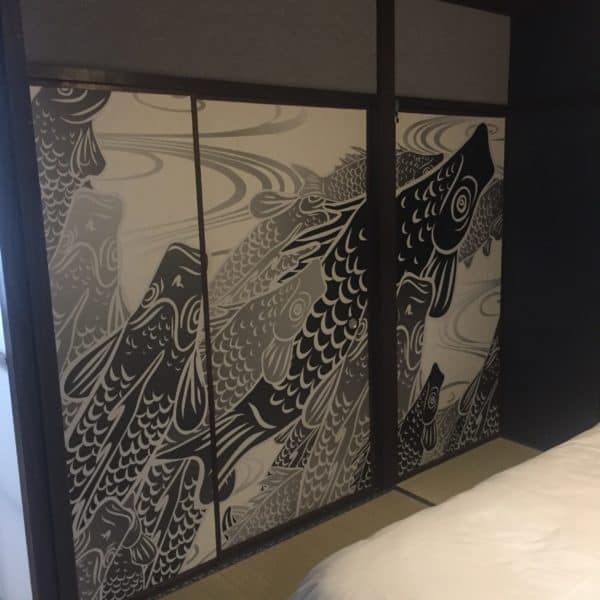
We had lunch at a dumpling place that had a good review on Yelp. This is something Ted navigates, and I have to admit that sometimes we walked further than I would have liked, but this meal was worth it.
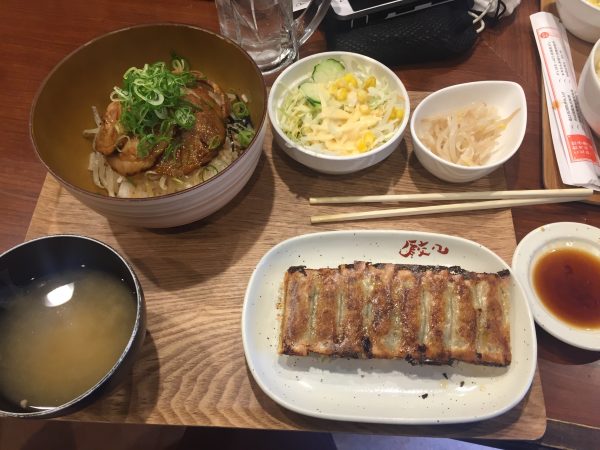
There are paper lanterns all over the place in Japan. I learned how to make the chochin style lanterns years ago and have taught the project many times. It’s a fascinating construction. In the old days, lanterns adorned shrines (they still do) and were hung outside of shops – today many of them have beer advertisements printed on them and since I don’t read Japanese, I’m not sure what else they say! Here’s the largest lantern I saw – approximately six feet in diameter – at a shrine tucked in between the high rises of Kyoto (which were surely built around the shrine and garden).
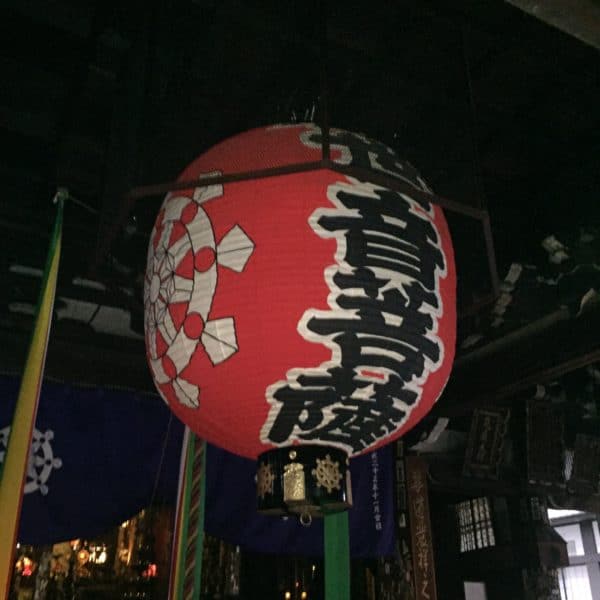
We ended the day at Morita Washi, my favorite paper store. I think there are many factors in deciding what’s a favorite, and this one mostly had to do with my energy that day and that I felt like shopping (or maybe it really is the best :), but there were many other paper shops we didn’t even get to in Kyoto). I purchased quite a few papers, and I wish I’d had the patience to look through the plain wall of washi papers – I noticed they had quite a few from Echizen, which we visited last week – but they were packaged in a way that wasn’t really conducive to browsing. It is also a challenge when you don’t speak the language!
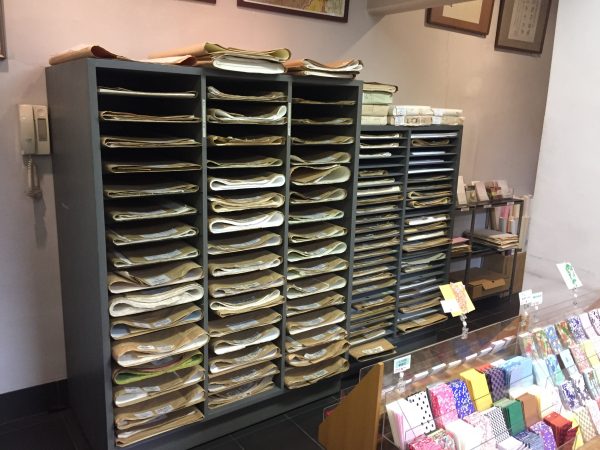
Here’s the largest display of mizuhiki cord I’d ever seen. Mizuhiki is a strong, string-like material made from the inner bark of the kozo plant, that is wrapped in silk creating a flexible yet durable cord. It is then used to create many beautiful embellishments.
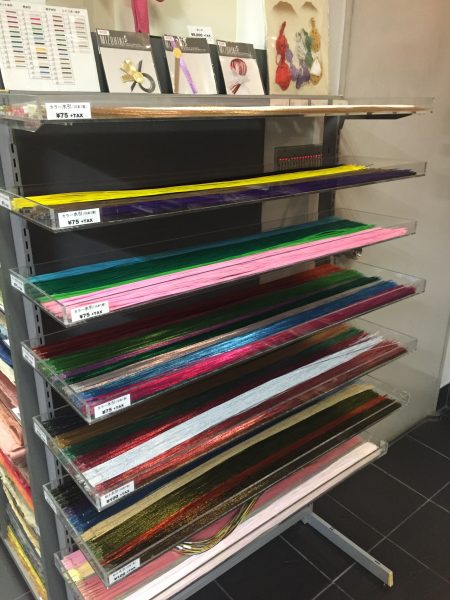
Small cards & envelopes.

There were so many decorative and colored papers in all sizes:
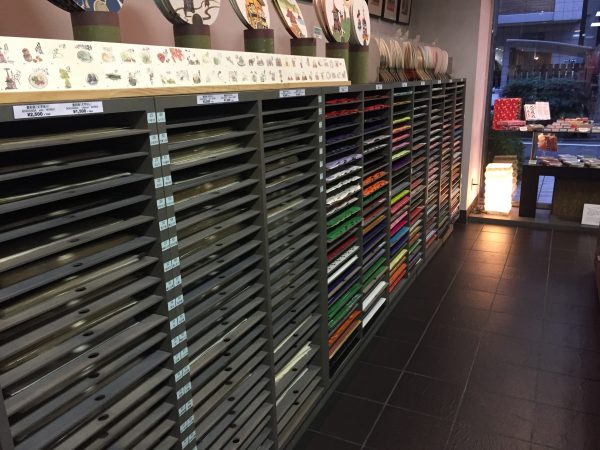
Here’s an overview of the shop. Ted even found a few things to purchase as gifts.

––––––––––––––––––––––––––––––––––––––––––––––––––––––––––––––––––––––––
Tuesday, 12/3: Richard Flavin, an American who has lived in the Tokyo area for five decades, gave me the name of a lantern shop in Kyoto where they make traditional lanterns, and when I visited Sarah Brayer last week, she called the shop and arranged an appointment. I’m still not sure how we got so lost, but it made for an adventure. First, the guy Sarah called (who speaks English), told me he would e-mail me the address (I’d filled out a form on their web page saying I wanted to visit, so he already knew of me). He didn’t send me the address, but I really wanted to go, so we looked it up on google maps and headed out. We ended up on the wrong bus, got off and walked the rest of the way.
When we arrived at what we thought was Kojima Lanterns, I announced myself to a gentleman who spoke a bit of English. It took awhile to realize we weren’t in the right place – the sign for the shop said something about interiors, so it seemed right. Finally, after I explained that I’d called and made an appointment, he went upstairs and to get a man who spoke better English. This guy was amazing! First, he confirmed we were in the wrong place, and then he called Kojima Lanterns, found out their location, and said he’d help us get a taxi (explaining that the place would be hard to find and he should tell the driver how to get there – aha)! On our way to a busier street to find a taxi, he asked me what I do, and then he said I might be interested in this little shop right across the street called Karamura.

He took us in and introduced us to the shop keeper, a very friendly woman who gave us a short tour. They block print papers for a variety of interior purposes and also offer short hands-on workshops! They have a lovely showroom. She took us upstairs to the workshop, where she showed us how the wood blocks are set up to step and repeat on large sheets of paper.
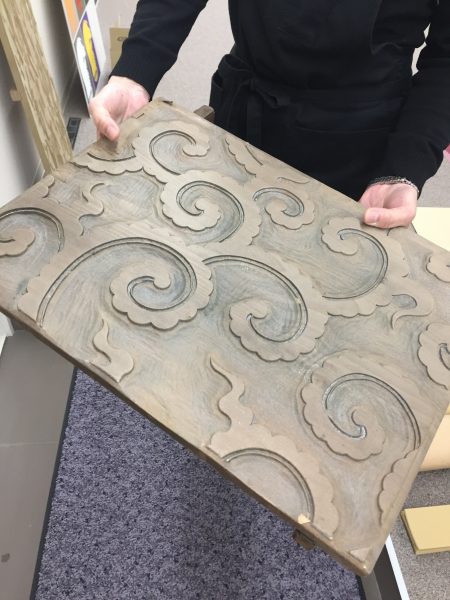
I was preoccupied with wanting to get to the lantern shop, so I didn’t get great photos, but take a look at that persimmon paper stencil on this shelf.
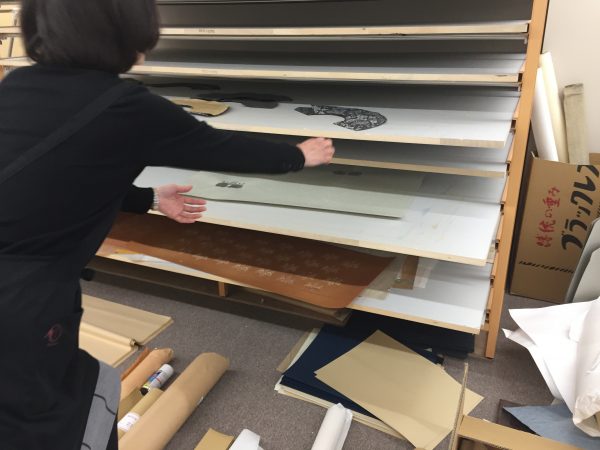
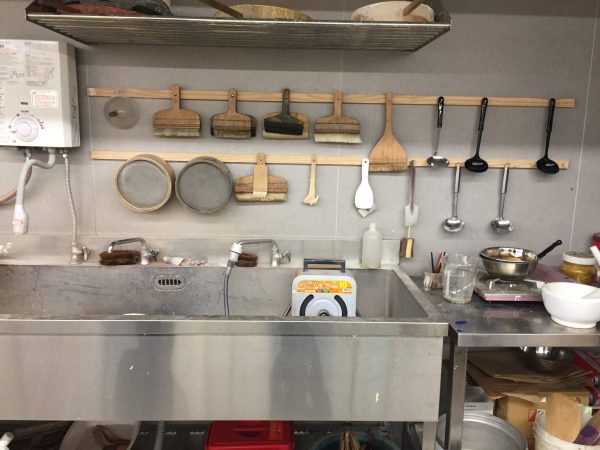
We also saw several historic wood blocks from the Edo period, brushes, ink with mica, and more. She explained that this karakami shop is one of two left. There used to be 100 shops in Kyoto!

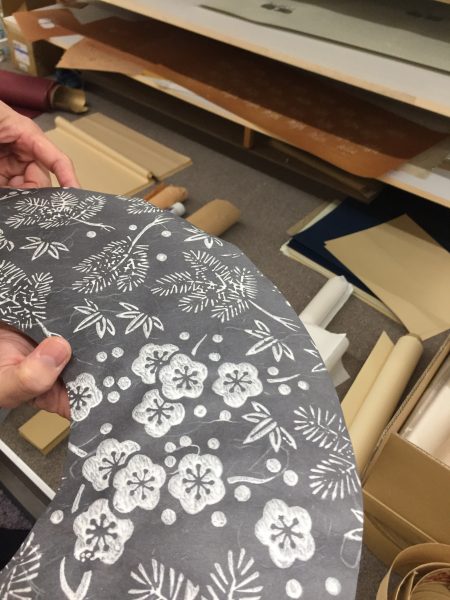
We took the taxi to Kojima Lanterns, where 4 people worked in a small Japanese-style room (everyone was working on the floor; there were no tables). One of them cuts the lengths of bamboo, one strips the bamboo, one wraps the bamboo onto lantern forms, and one applies the paper. This was a working studio, and I was a bit nervous about taking too much of their time, so I didn’t ask too many questions. Sadly, I’d also forgotten to bring my catalog along, so that I could show them how I’ve adapted their technique (I’ll have to go back)!
They told me they have at least 100 different lantern forms, like this one you see made from wooden ribs that are held in place with the circular pieces with notches at the top and bottom (I’ve made these from foam core – this is a project in my book, Paper Illuminated). The shape below is not a traditional shape.
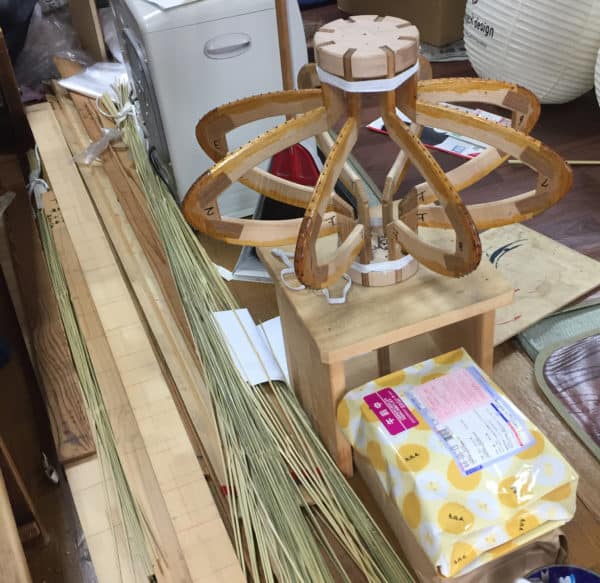
These wooden forms are 100+ years old, and Kojima Lanterns makes lanterns for hotels, shops, and replacement lanterns for shrines. This guy cut me a sample of some bamboo strips lickety split (no pun intended). He turned one strip (like you see sitting on the floor) into that series of strips – a true craftsman.
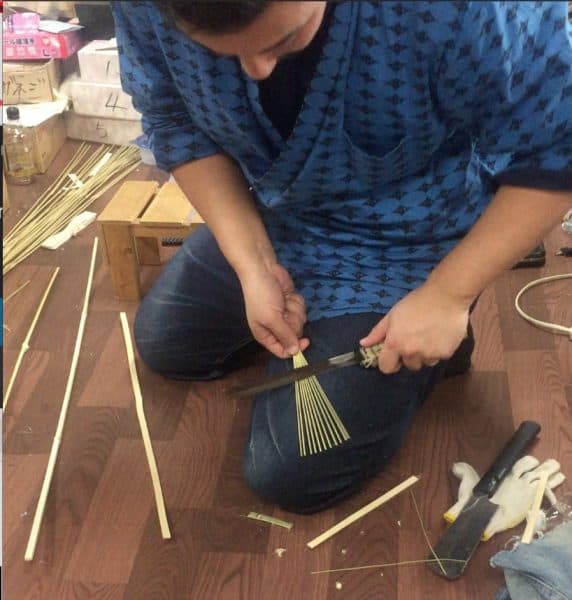
They told me that they make Kyoto style lanterns, making rings of bamboo rather than one spiral that winds its way around the form. So now I know, I learned the Kyoto style!

If you look closely, this woman has a form on a simple device that allows her to spin it when applying paper. So simple, yet brilliant!

And here you can see a finished papered lantern (although many get painted).

Ted had told me it had better be worth the visit, since we had such an adventure getting there. He seemed surprised when we stepped out of the place and I said that it was definitely worth it. In fact, it was a highlight of my career!
I wanted to visit the factory that makes the Noguchi Lamps (Ozeki Lantern) in Mino, but I wasn’t able to make a connection there, and it was a bit of a hike from Kyoto. Next trip! If you don’t know the story of Isamu Noguchi and his Akari lights, look him up. It begins in Mino, and his lamps have become iconic.
After that we wandered through the streets towards Kamiji Kakimoto, another paper shop with similar papers to Morita and a bit more pricey. I didn’t buy anything, and after reliving what we’d already done that day, I can see why I didn’t feel like shopping. Ted was happy to find a little bakery nearby, where he bought a few treats.
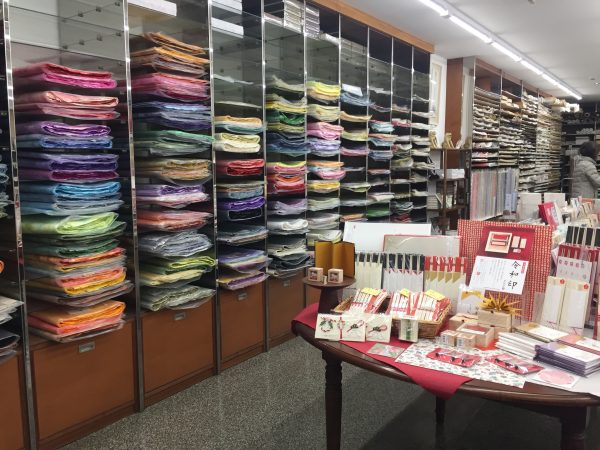
But serendipty struck. I stumbled across a brochure about a collaboration between Kojima Lanterns and the artist Mika Horie, which was somehow sponsored by the shop. She made these chochin lanterns with indigo painted panels. I wondered why the people at Kojima didn’t mention this to me, but again, I forgot to bring anything to show them, and I’m not sure they understood that I make lanterns. And I was too tired to talk to anyone at the paper store. This will be something else to follow up on my next trip!
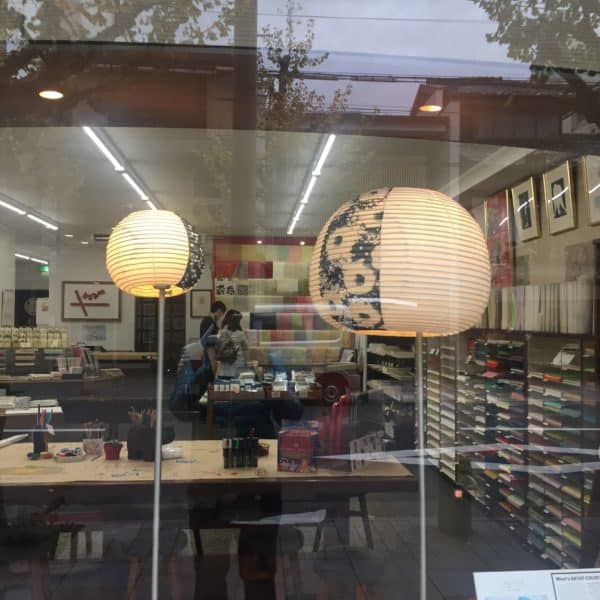
This was a never-ending day. This paper store was in a posh district with nice shops, and we found the MoMA store with some really unique, partially paneled chochin in the shop next door. These were probably the most contemporary lamps I saw on this trip.
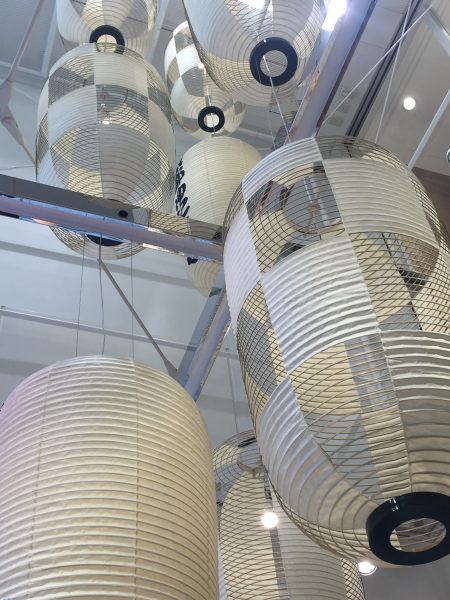
We kept walking, through another huge nice bookstore; had coffee in a cute little shop that also sells cars, and then wandered over to the Philospher’s Path to see a shrine Craig told us about, called Honen (there’s a photo of it at the link). Check out the raised raked sand bed. I thought that was unusual – the raised part.
And lo and behold, on our way along the path, we came across a small paper shop! You can see that it was dark out by then.
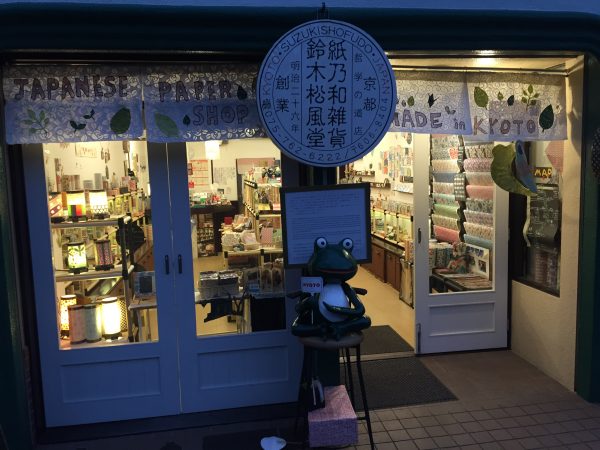
––––––––––––––––––––––––––––––––––––––––––––––––––––––––––––––––––––––––
Wednesday 12/4: We finally got on the bikes and rode 3+ miles to meet Will at Zuihon temple for a tea ceremony with an abbot that Sarah Brayer’s husband had arranged. Ted and I lived in a sweet little Japanese house in Portland when Will was born, and there was a Japanese tea house on the property. The owner was a tea sensei, and we had the pleasure of experiencing the Japanese tea ceremony a couple of times when we lived there. But due to the language barrier and Will being a bit shy (he does speak Japanese) we ended up being served tea, without any ceremony.
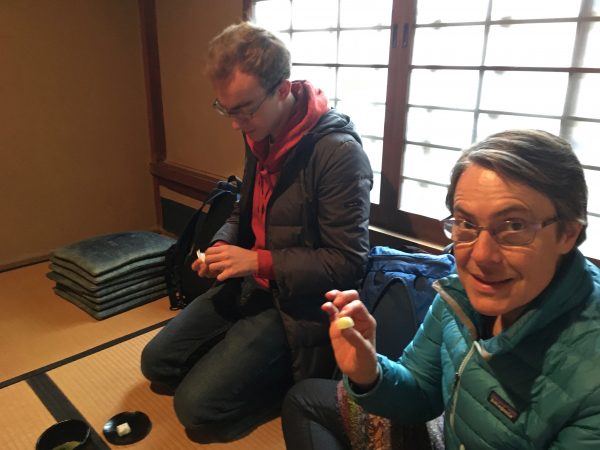
We had udon for lunch and then Will had to go to class, so Ted and I rode 4-5 more miles to Arashimaya Bamboo Grove and walked through it with a ton of tourists. We weren’t really sure where to park our bikes (we didn’t see any other bicycles anywhere) so we took them with us on the path. I had a one-speed bike and Ted’s was a folding bike, so they weren’t exactly the best touring bikes, and we had a few hills to climb.
One funny aside: Ted was navigating via google maps on his Apple Watch, and at one point he realized (at the bottom of a long hill) that we’d missed our turn a ways back. He turned into a parking area that was being monitored by a guard, who immediately started waving his arms and indicating that we shouldn’t be there. We turned around and went back up the hill…
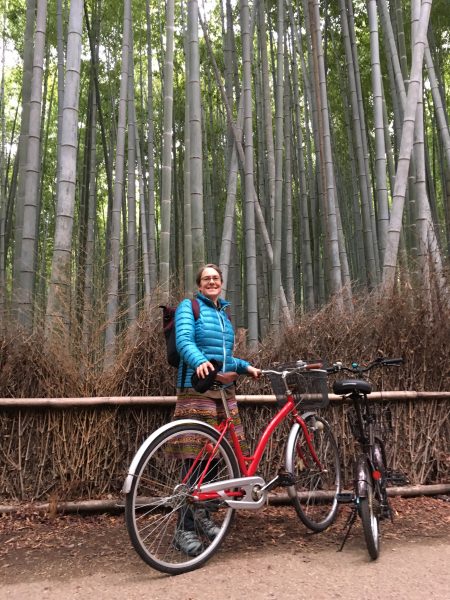
These scarecrows were in a field on our way to the bamboo forest.
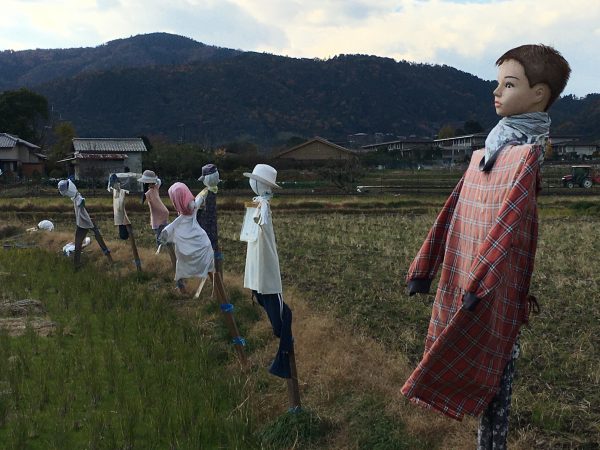
The forest was lovely.
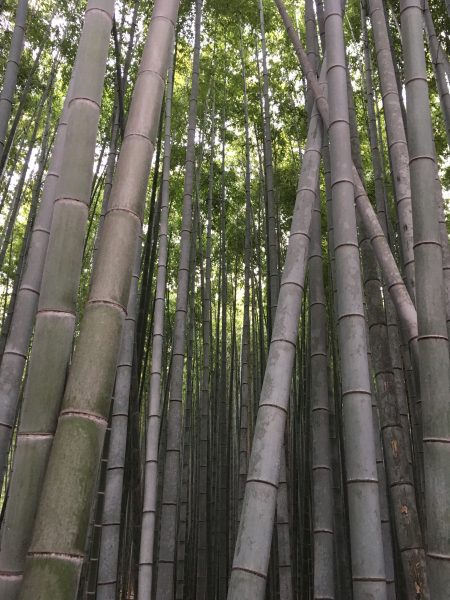
One more comment about biking. I was pleased to not feel too out of shape. I swim and walk alot, but haven’t been on a bicycle in years. And I was happy to be off of my feet, which were sore from so much walking. But after this day of cycling, my butt was sore!
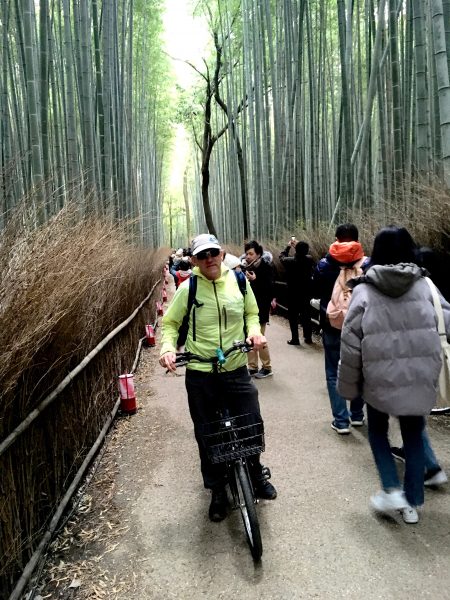
We rode all the way back home through the misty rain, with a stop for coffee on the way. That evening, we enjoyed dinner in our neighborhood at a Nepalese restaurant, which had these modern looking lamps featuring lace paper hanging above the tables.
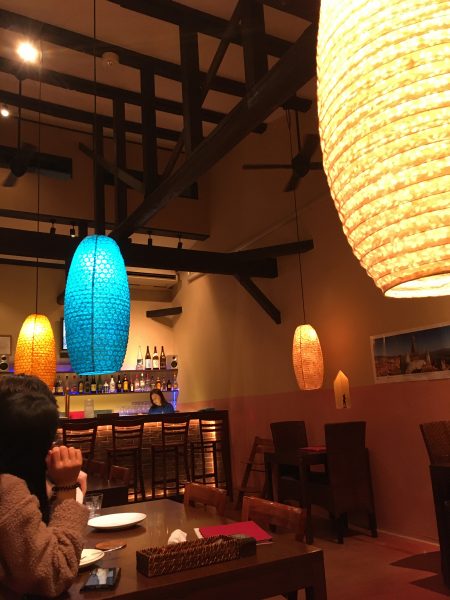
––––––––––––––––––––––––––––––––––––––––––––––––––––––––––––––––––––––––
Thursday 12/5: Sake and Whisky day. We went to Fujimi, a cute little area on a canal which is lined with cherry blossoms in the spring, where we visited a few sake breweries, picked up some sake, and had lunch in a popular restaurant (there was a 20 minute wait). I was more interested in the sake stomping boots and barrels than the actual sake.
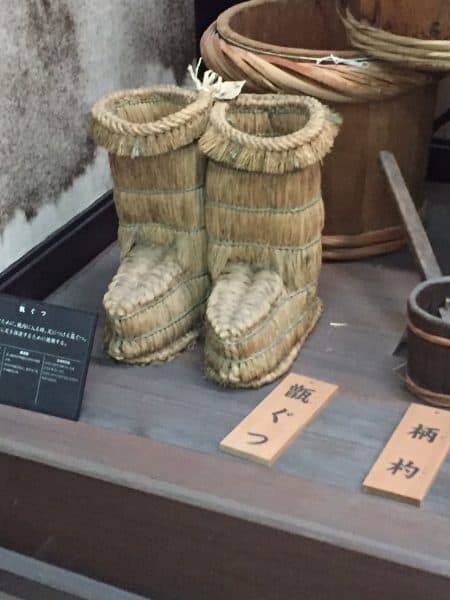
Check out that basket weaving on such a grand scale!
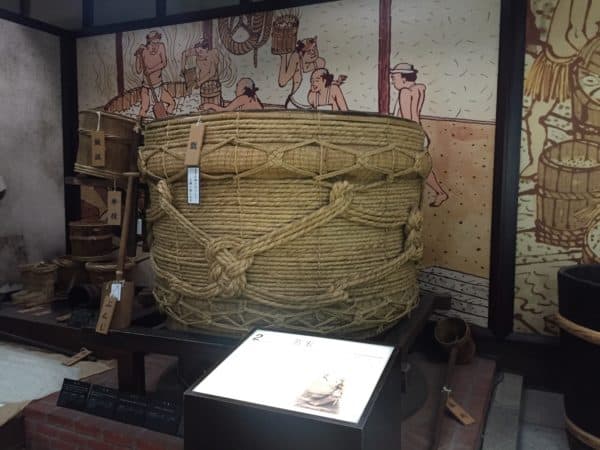
Then we took the train to the Suntory Whiskey Distillery for another self-guided tour, tasting and purchase.
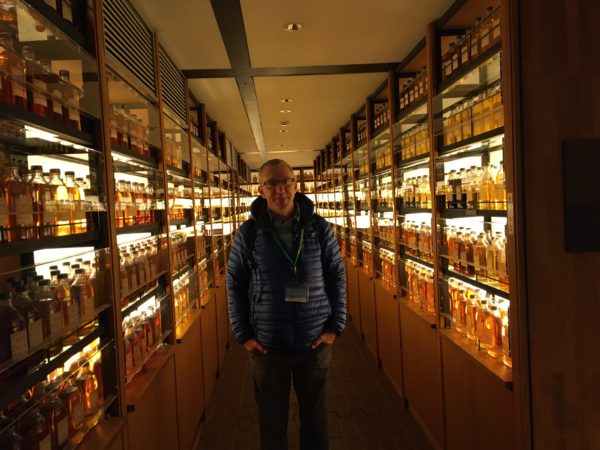
I’m not a big drinker, so I opted to just take a sip of Ted’s $30 tasting (the bottle costs $5,000; we didn’t get one).

We ended the day at our son’s home and met his host parents and two brothers in their 20’s (one of them was taking this photo). Will’s room was SO cold, which is perhaps customary in Japan? There was heat in the living room and kitchen, where we hung out, but the entryway and his room were cold. He has a sitting desk that is heated, and he had never mentioned that the house was cold, but wow!

––––––––––––––––––––––––––––––––––––––––––––––––––––––––––––––––––––––––
Friday 12/6: Our last day! We got on the bikes again and rode 4km to the cable car that takes you to the top of Mt. Hiei. Ted had read about this and wanted to go. This was the steepest climb I’d ever seen on a cable car, but there was hardly a view at the top, and it was freezing cold. After coming back down, we realized there was a second cable car in another spot (only 200m away) – maybe that’s the one we should have taken. We rode back to our neighborhood and had one last hot ramen meal. Travel fatigue had begun to set in, so we didn’t do anything else that day, aside from packing.
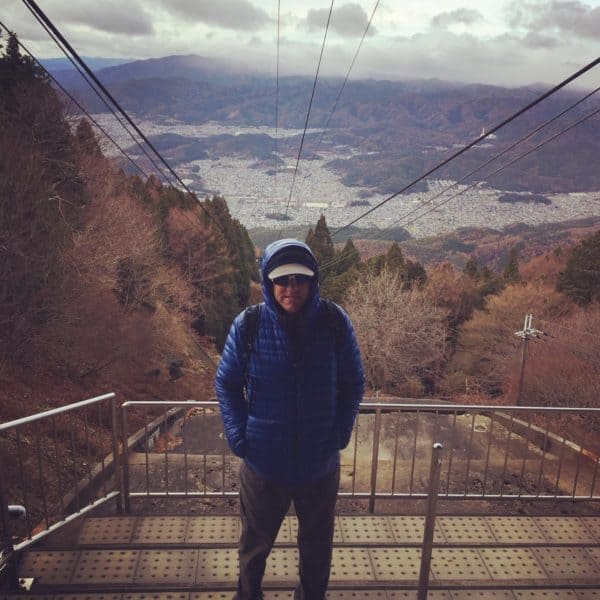
Oh my goodness! I’m so happy I decided to recap my trip in blog form – it was fun to relive it and to get the facts down (for reference). Thanks for following along!
I think I’ll write one more post about the papers I purchased. Stay tuned! And I have to tell you that just yesterday, Ted told me he’s thinking of pitching a story about Echizen and Japanese papermaking to a major publication. Regardless of whether he makes the pitch (and whether it gets accepted, because getting published is very competitive), I feel honored and it feels validating: he realizes that what I do is really a thing!
Guess what? I am seriously considering bringing a group to Japan in 2021. I think I’ve found a partner on the ground there who speaks Japanese. Please leave a comment if you think you might be interested (please include your e-mail address, because it won’t show up with your comment). I am envisioning a trip that would combine visiting paper places and creating Japanese-inspired paper objects. In the meantime, I hope to attend the IAPMA Congress in Japan next fall.
And I know you see this every week on my blog, and you probably don’t even look at it anymore, but these two posts about Japan took me over 10 hours to compile (without compensation). I am by no menas complaining – I feel so lucky to have found a true passion – and I do so love and enjoy what I do! But here’s a fact: my hubby (the writer and editor) gets $1-$2 per word when he writes a magazine article.

And feel free to SHARE THIS blog post with your paper- and Japan-loving friends!

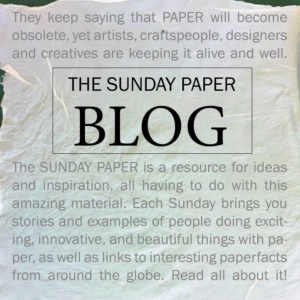
19 Comments
Oh, Helen, what an exciting trip. If I can get the money together by 2021 I’d love to go to Japan with you. I’ve been wondering how to get there and find the right places on my own and it would be so much better to be with other paper lovers.
very best wishes,
Viv Mullett
Hi Viv, yes. I’m glad you’re interested. Stay tuned – I know planning is important (for everyone) so I first have to decide for sure that I want to do this, and then I’ll get organized so that you have plenty of lead time!
Oh my gosh Helen, what an amazing trip! Thank you for taking the time to organize your thoughts and photos and sharing them with us. I’ll keep my fingers crossed in re Ted’s pitch.
xo,
Daria Wilber
Thanks, Daria, and thanks for sharing my post! I wasn’t sure I wanted to organize my thoughts at first, but it was really helpful for me too!
Wow such an uplifting account of your adventures, discoveries, delights, and challenges. I hear the enthusiasm in your writing voice. It would be an amazing gift to take a group. I’m in. Keep dreaming……
Carol
Wonderful account of your trip, Helen! My husband and I will be in Japan in about 3 months, and I’m so looking forward to it. I’m anxious to read your account of the papers you bought!
Awesome! Have a great time.
We have a friend in Tokyo who makes miniature artist books. She promised to take us on a tour of paper shops and bookstores. 😊
I would love to be kept abreast about a Japanese tour in 2021. Your trip sounds da like it was amazing.
Got it, Leslie. Thanks for your interest. Can you give me your e-mail address please?
Thanks, Carol :).
Helen: your work is inspiring and I would be interested in participating in a japan trip in 2021.
I live in Canada so please let me know.
Sarah, I forgot that wordpress doesn’t show me e-mail addresses. Can you please send me yours? Thank you! And if it’s easier: helen@helenhiebertstudio.com
Helen, I loved your blog and am ready to pack and go. Please add me to your list of people interested in joining you for a trip to Japan in 2021. Thank you.
Aww, thanks Susan! And special thanks for your donation.
Hi, Helen,
I might consider going to Japan with you! Depends on when you go. Please keep me posted!
Thanks!
Helen
Very interested in the 2021 Japan trip. Please keep me in mind.
Lou
Thanks for `sharing your trip. Truly enjoyed it.
Helen, thanks for sharing your visit and I’m so glad you got to ITOYA. I was on an art trip to Japan a year ago but as it wasn’t strictly paper-oriented I didn’t see most of the places you managed to get to.
I would be interested in receiving information from you if you decide to run a tour in 2021, even though I’m in Australia. You should have my email address already.
Regards,
Claire Brach.